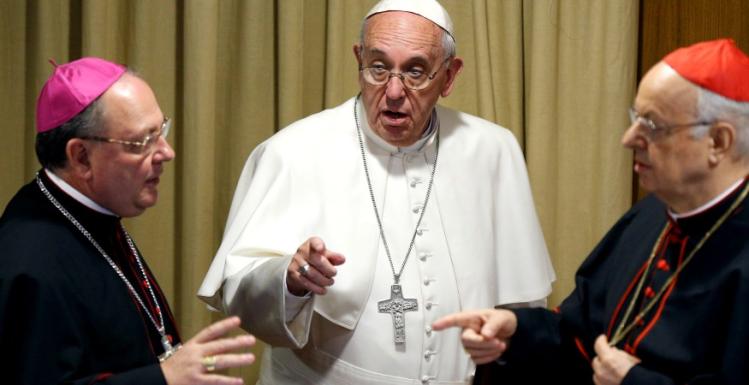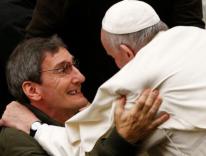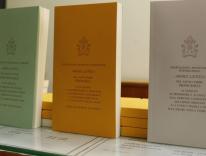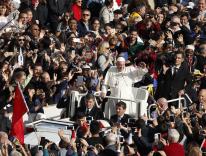
It has been known for quite some time that a number of cardinals and bishops, both in Rome and abroad, are—to put it mildly—uncomfortable with the way Pope Francis’s pontificate is unfolding.
Well, this week it all spilled out into the open when it was unveiled that several cardinals—including three top Vatican officials (Cardinals Pell, Müller and Sarah)—wrote a letter to the Pope that basically criticized the way he is running the Synod of Bishops.
One should be magnanimous and give these birds credit for being honest with the Pope and telling him their concerns. (They were not happy that the public found out, which is another story.) But one should also be aware that, at least some of these prelates, are active ringleaders of an opposition to Francis.
As the Vatican II-minded theologian, Enzo Bianchi, noted this week in the Rome daily, La Repubblica, they have at times waged a fierce battle.
Bianchi, who is founder and prior of the Ecumenical Monastery of Bose in Northern Italy, said, “What’s at play here is not Catholic doctrine on the indissolubility of marriage… No, it’s the pastoral dimension, his attitude towards those who make mistakes and towards contemporary society.” Then he thundered: “Let’s be clear – what scandalizes them is mercy!”
Who knows if Pope Francis read that article on Wednesday after saying his morning prayers and before heading to his two-pronged general audience in the Paul VI Hall (for several hundred sick and handicapped people) and St. Peter’s Square (for the rest of the visitors)?
But it did not seem to be a coincidence that, as he began to read his prepared remarks to the tens of thousands of people in the square, he put down his pages and said, “Before beginning this catechesis I would like, in the name of the Church, to ask your forgiveness for the scandals that have occurred recently both in Rome and in the Vatican. I ask your forgiveness.”
To which scandals was he referring? There have been a few in the last several weeks – like the Polish monsignor and former Vatican official who “came out” and admitted to being in a gay relationship. And there was the former nuncio and defrocked archbishop, also Polish, who died this past summer while awaiting trial for sexually abusing adolescent boys.
Obviously, the Pope was not referring to the scandal of mercy. But he could have had in mind the scandalous behavior of those who, in these days, are leading the opposition to his mission of mercy.
****
Pope Francis does not seem to be overly nervous about those bishops who are not entirely “on message”—that is, those who don’t agree with him on everything or do not share his style of episcopal ministry. Nor should he be.
He is the first to say—indeed, to promote the idea—that we can accommodate a great deal of diversity within the Catholic community without being worried that it will diminish Church unity.
Still, it is hard to understand how any pope could tolerate blatant opposition to him coming from within the very structure that is supposed to be, principally, at his service—that is, the Roman Curia.
The titular bishops or emeritus diocesan ordinaries that work in Vatican offices are already a bit of an anomaly. They are, in effect, bishops without a people. Their main task should be to support the Bishop of Rome in his universal ministry, not put up obstacles.
There have been uncooperative Curia prelates in every pontificate, but former popes usually kicked them upstairs or sent them somewhere else to neutralize them and thwart their negative influence. Mostly these were officials inherited from their predecessor. Surprisingly, Pope Francis has not done this, except on very few occasions.
The transfer of the conservative Cardinal Mauro Piacenza from the Congregation for Clergy to the Vatican’s tribunal for the internal forum and indulgences is one example. His removal of Cardinal Raymond Burke as head of the Church’s supreme court, sending him to be the glorified chaplain and cardinal-protector of the Knights of Malta, is another.
But most everyone else Francis found on the upper rungs of the Curia hierarchy when he arrived have kept their jobs.
Part of the reason is that the man who put them there—Benedict XVI—is still around and living in the Vatican Gardens. The ex-pope saddled Francis with people like Gerhard Müller (prefect for the Congregation for the Doctrine of the Faith) and Georg Gänswein (prefect of the pontifical household) after he had already decided (but before announcing) that he was going to resign the papacy.
Francis could have dismissed both of them. Instead, he made one of them a cardinal and kept them both in their jobs. More difficult to understand is why he appointed Cardinal Robert Sarah head of the Congregation for Divine Worship.
None of the three are enthusiastic supporters of the general and overall thrust of this pontificate. They have, at various times, publicly voiced concern over the direction it has taken. More serious, however, is what is happening behind the scenes. Unfortunately, as long as the retired man in white is still in Rome they won’t be going anywhere.
****
Cardinal Loris Capovilla has turned 100 years of age. The man who was personal secretary to Pope John XXIII, even when the now-sainted pontiff was Patriarch of Venice, marked the milestone on Wednesday. He is more than three years older than anyone else in the College of Cardinals.
You may recall that when Pope Francis announced his first group of new cardinals on 12 January 2014, Capovilla was the first of three men over the age of eighty chosen to receive the red hat. He was already ninety-eight at that time. Francis wanted to honor Capovilla (a bishop since 1967) for reasons obvious to just about everyone except, perhaps, the two popes that preceded him. In the five decades since John’s death he has been the living memory of the beloved pope that called Vatican II.
“To speak of Capovilla is to speak of Pope John, and to speak of them both is to speak of the Council—with no ifs, ands or buts,” wrote Carlo Di Cicco, then assistant editor of L’Osservatore Romano. Noting that Paul VI named him a peritus at Vatican II after John XXIII's death, Di Cicco said Cardinal Capovilla’s “entire life speaks of the Council.” Pope Francis wanted to give him the red hat, said Di Cicco, precisely because he was “such a remarkable witness of Vatican II.”
Francis’ predecessors evidently did not think so. After Pope John’s former secretary turned eighty in 1995 there were some eight consistories over a fourteen-year stretch (1998-2012). John Paul II held three of them and Benedict XVI another five. Together they gave red hats to twenty-five men beyond the Conclave voting age. But never to Loris Francesco Capovilla.
Thanks to Pope Francis we can all now say: “Happy birthday, Eminenza!"
Please email comments to [email protected] and join the conversation on our Facebook page.
Previous Story
Adults Meet and Debate—like Adults
Next Story
Scoring Last Night's Democratic Debate


